Categories more
- Adventures (17)
- Arts / Collectables (15)
- Automotive (37)
- Aviation (11)
- Bath, Body, & Health (77)
- Children (6)
- Cigars / Spirits (32)
- Cuisine (16)
- Design/Architecture (22)
- Electronics (13)
- Entertainment (4)
- Event Planning (5)
- Fashion (46)
- Finance (9)
- Gifts / Misc (6)
- Home Decor (45)
- Jewelry (41)
- Pets (3)
- Philanthropy (1)
- Real Estate (16)
- Services (23)
- Sports / Golf (14)
- Vacation / Travel (60)
- Watches / Pens (15)
- Wines / Vines (24)
- Yachting / Boating (17)
Your Culinary Canvas Glass Splashback for Contemporary Living
Published
06/04/2024In interior design, the kitchen has evolved from merely a functional space for food preparation to a central hub of the home, where culinary creativity meets aesthetic appeal. Among the various elements that contribute to a modern kitchen's visual and practical aspects, glass kitchen splashbacks have emerged as a popular choice for homeowners seeking both style and functionality. In this comprehensive exploration, we delve into the myriad benefits and design possibilities of glass splashbacks, elucidating how they elevate the culinary canvas of contemporary living spaces.
Chapter 1: The Evolution of Glass Splashback Design
- Historical overview of kitchen design, from utilitarian spaces to integrated living areas.
- The rise of open-plan kitchens and their impact on interior design trends.
- We are changing consumer preferences towards seamless, sleek, and minimalist aesthetics in kitchen décor.
- Introduction of innovative materials and technologies reshaping the kitchen design landscape.
Chapter 2: Understanding Glass Splashbacks
- Definition and purpose of glass splashbacks in kitchen design.
- Types of glass used in splashbacks: toughened glass, mirrored glass, tinted glass, etc.
- Functional advantages of glass splashbacks: hygienic surface, easy maintenance, heat resistance, and durability.
- Aesthetic appeal: enhancing natural light, creating the illusion of space, and reflective properties.
- Sustainability aspects of glass as a material choice in kitchen design.
Chapter 3: Design Possibilities with Glass Splashbacks
- Customisation options: colour choices, patterns, textures, and finishes.
- We incorporate artwork and digital printing onto glass splashbacks for personalised design statements.
- Integration of lighting elements to accentuate glass splashbacks and create ambience.
- We are combining glass splashbacks with other materials, such as stainless steel, stone, or wood, to create eclectic design compositions.
- Case studies highlighting innovative applications of glass splashbacks in modern kitchen designs.
Chapter 4: Installation and Maintenance Considerations
- A step-by-step guide to the installation process of glass splashbacks.
- Importance of professional installation for precision and safety.
- Maintenance tips for preserving the pristine appearance of glass splashbacks.
- Cleaning techniques and recommended products for removing stains, grease, and fingerprints.
- We are addressing common concerns regarding the durability and longevity of glass splashbacks.
Chapter 5: Cost Analysis and Budgeting
- Factors influencing the cost of glass splashbacks: size, complexity of design, material quality, and installation.
- Comparison of costs between glass splashbacks and alternative materials like tiles, stainless steel, or stone.
- Strategies for budgeting and optimising expenditure when incorporating glass splashbacks into kitchen renovations or new builds.
- Return on investment: assessing the value-added benefits of glass splashbacks in property resale.
Chapter 6: Trends and Innovations in Glass Splashback Design
- Emerging trends in colour palettes, patterns, and finishes for glass splashbacks.
- Sustainable practices in glass manufacturing and recycling.
- Technological advancements enabling greater customization and design flexibility.
- Integration of intelligent features such as touchscreen displays or LED lighting within glass splashbacks.
- We are forecasting future developments and the evolving role of glass splashbacks in kitchen design.
Chapter 7: Case Studies: Inspirational Glass Splashback Installations
- Showcase of diverse kitchen designs featuring glass splashbacks, including urban chic, Scandinavian minimalism, and Mediterranean-inspired aesthetics.
- Interviews with homeowners, interior designers, and architects on their experiences incorporating glass splashbacks into kitchen projects.
- Before-and-after transformations highlighting the transformative impact of glass splashbacks on outdated kitchens.
- We are exploring the intersection of functionality, creativity, and personal expression in real-life kitchen designs.
- Prepare the Surface: Ensure the wall surface where the splashback will be installed is clean, dry, and free from any debris or grease. Smooth out any irregularities or bumps that could affect the fitting.
- Measurements and Cutting: Accurate measurements are crucial. Measure the area where the splashback will go and transfer these measurements to the glass. Use safety equipment such as gloves and goggles, then cut the glass according to the measured dimensions. Consider hiring a professional glass cutter if you're uncertain about cutting the glass yourself.
- Adhesive Application: Apply an appropriate adhesive recommended for glass splashbacks onto the back of the glass. Follow the manufacturer's instructions regarding the application method and coverage. Apply the adhesive evenly to ensure a secure bond.
Conclusion:
Glass splashbacks have transcended their utilitarian function to become a signature element of contemporary kitchen design, offering a blend of style, functionality, and versatility. As homeowners increasingly prioritise aesthetics and practicality in their living spaces, the demand for innovative solutions like glass splashbacks continues to soar. By upgrading your culinary canvas with glass splashbacks, you not only enhance the visual appeal of your kitchen but also elevate the overall ambience and functionality of your home. Embrace the possibilities of glass splashbacks and embark on a journey of culinary creativity and modern living.















